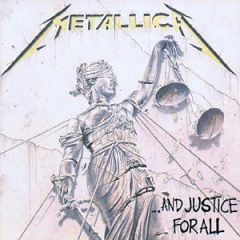Metallica - ...And Justice for All [1988]
Metallica - ...And Justice for All [1988]

01.Blackened (6:42)
02.And Justice For All (9:45)
03.Eye Of The Beholder (6:27)
04.One (7:24) play
05.The Shortest Straw (6:35)
06.Harvester of Sorrow (5:45)
07.The Frayed Ends of Sanity (7:43)
08.To Live Is To Die (9:50)
09.Dyers Eve (5:14) play
Personnel
* James Hetfield – lead vocals, rhythm guitar
* Kirk Hammett – lead guitar
* Jason Newsted – bass, backing vocals
* Lars Ulrich – drums
The most immediately noticeable aspect of ...And Justice for All isn't Metallica's still-growing compositional sophistication or the apocalyptic lyrical portrait of a society in decay. It's the weird, bone-dry production. The guitars buzz thinly, the drums click more than pound, and Jason Newsted's bass is nearly inaudible. It's a shame that the cold, flat sound obscures some of the sonic details, because ...And Justice for All is Metallica's most complex, ambitious work; every song is an expanded suite, with only two of the nine tracks clocking in at under six minutes. It takes a while to sink in, but given time, ...And Justice for All reveals some of Metallica's best material. It also reveals the band's determination to pull out all the compositional stops, throwing in extra sections, odd-numbered time signatures, and dense webs of guitar arpeggios and harmonized leads. At times, it seems like they're doing it simply because they can; parts of the album lack direction and probably should have been trimmed for momentum's sake. Pacing-wise, the album again loosely follows the blueprint of Ride the Lightning, though not as closely as Master of Puppets. This time around, the fourth song -- once again a ballad with a thrashy chorus and outro -- gave the band one of the unlikeliest Top 40 singles in history; "One" was an instant metal classic, based on Dalton Trumbo's antiwar novel Johnny Got His Gun and climaxing with a pulverizing machine-gun imitation. As a whole, opinions on ...And Justice for All remain somewhat divided: some think it's a slightly flawed masterpiece and the pinnacle of Metallica's progressive years; others see it as bloated and overambitious. Either interpretation can be readily supported, but the band had clearly taken this direction as far as it could. The difficulty of reproducing these songs in concert eventually convinced Metallica that it was time for an overhaul. ---Steve Huey, AllMusic Review
To monumentalny, porażająca dźwiękiem, nagromadzeniem riffów i przepychem gitarowego grania album, w wersji winylowej dwupłytowy. Wydany w sierpniu 1988 roku, a nagrany już po tragicznej śmierci Cliffa Burtona. Utwory są tu długie. Trwają zwykle po osiem, dziewięć minut. Niektóre z nich to prawie mini suity – jak choćby rzecz tytułowa. Z delikatnym, akustycznym wstępem, z nagłymi zmianami nastroju, z pogmatwanym na różne sposoby rytmem. Można powiedzieć, że to chyba najbardziej ze wszystkich perkusyjna płyta zespołu. Lars Ulrich rządzi i dzieli. Niczym pan i władca z niezwykłą siłą napędza tę metalową nawałnicę pełnego patosu grania.
Jednak tak naprawdę ostro, czadowo jest jedynie w otwierającym album Blackened i zamykającym go Dyers Eve. Przytłaczające, thrashowe dźwięki gitarowe, wsparte nieco może zbyt delikatnym basem Jasona Newsteda i wspomnianym perkusyjnym motorem prą mocno do przodu. A gdy dodać do tego agresywniejszy niż na wcześniejszych płytach (szczególnie właśnie w Dyers Eve) śpiew Jamesa Hetfielda i oszałamiające mnogością dźwięków sola Kirka Hammetta… Pojawia się jakby nowy wymiar metalowego grania. Reszta płyty jest już nieco spokojniejsza, wyważona. Choć oczywiście nie ma to nic wspólnego z balladami (poza najsłynniejszą tu pozycją – One). Po prostu, każda kolejna kompozycja, czy będzie to Eye Of The Beholder (z doprawdy niesamowitym solem Hammetta) czy The Shortest Straw (z nieco synkopowanym podkładem) czy wreszcie Harvester Of Sorrow (z wokalnymi nakładkami Hetfielda w tle) to przede wszystkim mocne, „przysadziste” riffy. Zdawać by się mogło czasem, że grożące monotonią (wtedy na pewno przydają się poutykane tu i ówdzie akustyczne wstawki), nic jednak bardziej złudnego: ...And Justice For All nakręca się jak muzyczna sprężyna pękająca w ostatnim, urwanym nagle utworze płyty.
Wspomnieć trzeba o prawdziwych perłach. Oczywiście – wspomniane już One, reakcja na historię młodego człowieka koszmarnie okaleczonego przez wojnę (film Daltona Trumbo, Johhny poszedł na wojnę). Jest też w dużej mierze instrumentalny To Live Is To Die (gdzieś tak w ósmej minucie pojawia się kilka wypowiedzianych zdań). Jedyna tu kompozycja, której współautorem jest Cliff Burton. Oba utwory bardzo piękne, z chwytającymi za serce melodiami. Ale obie również z dawką złości i agresji, mocno pesymistyczne. Zresztą jak cała ta płyta. Tak sarkastyczna. Krytyka wymiaru sprawiedliwości w utworze tytułowym, bunt przeciw machinie władzy w Eye Of Beholder, alienacja w The Shortest Straw to tylko niektóre tematy tekstów Jamesa Hetfielda. Ja mu wierzę. Myślę, że kilkanaście milionów ludzi, którzy przez te dwadzieścia lat kupili tę płytę – również. ---Grzesiek Kszczotek, terazmuzyka.pl
download (mp3 @VBR kbs):
yandex mediafire ulozto cloudmailru gett
Last Updated (Monday, 09 July 2018 07:49)








